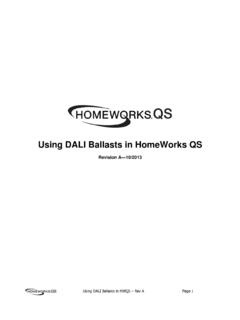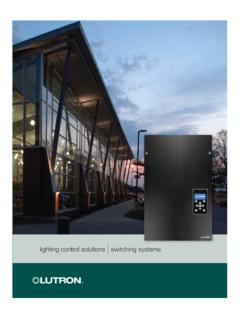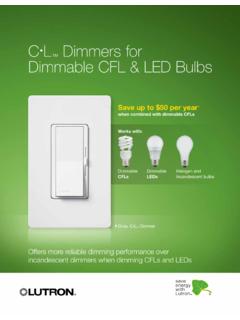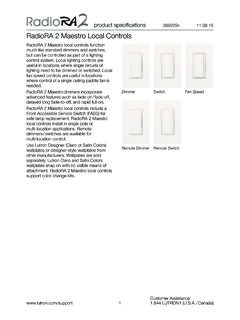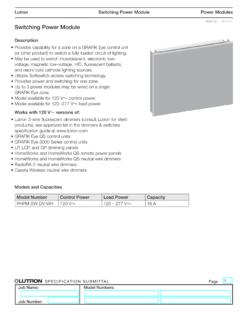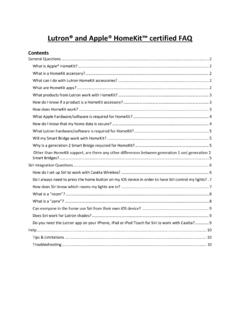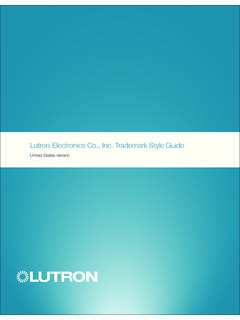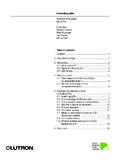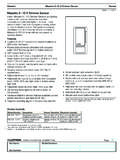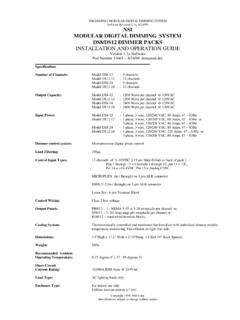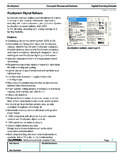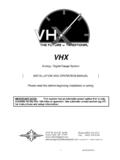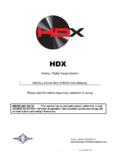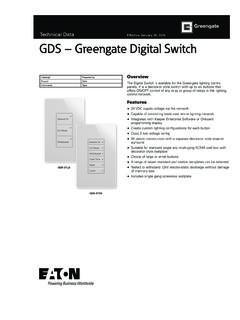Transcription of Fluorescent Dimming Systems Technical Guide
1 Fluorescent Dimming Systems Technical Guide Fluorescent Dimming Systems Technical Guide 02 lutron Fluorescent Dimming ballasts 04 How it works 05 Lamp information 06 Ballast factor 07 Ballast efficacy factor 08 Power factor 09 Total harmonic distortion 10 Ballast lifetime 11 Mounting and grounding 13 Sockets and lampholders 16 Lamp wiring diagrams For ballast model numbers 19 Ballast control types and control selections, please 20 EcoSystem ballasts see P/N 367-2248 REV A. 22 Emergency backup ballast 24 Ballast troubleshooting Innovation and quality from the world 25 Installation best practices leader in lighting controls 26 Appendix A: Application note 28 Appendix B: Application note lutron invented the world's first electronic Dimming ballast over 30 years 30 Glossary ago. lutron continues to lead the industry with innovative and energy-saving Fluorescent Dimming options, offering an extensive selection of ballasts and controls, and providing complete Fluorescent Dimming solutions.
2 This Guide is designed to be a complete resource for all Technical aspects of lutron Fluorescent Dimming Systems . The Technical Guide will review the basics of Fluorescent lamps and Dimming ballasts, including functional principles, lamp varieties, ballast factor, and lifetime expectations. Installation topics such as ballast mounting, grounding, lamp mounting height, wiring schemes, and troubleshooting will also be covered in detail. To search online for the ballast that best fits your project, visit the updated Ballast Selection Tool at lutron World Headquarters: Technical Support: 24 hours/7 days (US/CAN) lutron | 01. For a complete listing of model numbers, see the Fluorescent ballasts and LED drivers Selection Guide lutron Fluorescent Dimming ballasts or consult product pages on Low-end Integral Sensor Fluorescent ballasts Compatible Lamp Types and Wattages Input Voltage Control Options Available Case Types Dimming level Connections EcoSystem H-Series T8 linear and U-bent: 17 W, 25 W, 32 W UNV: 120 V, 220/240 V, EcoSystem digital link for T8 No ballasts T5 HO linear: 24 W, 39 W, 54 W 277 V @ 50/60 Hz 1% for T5 and T5 HO.
3 T5 linear: 14 W, 21 W, 28 W. M-case G-case EcoSystem H-Series T8 linear: 32W, 36 W 127 220 V INMETRO @ 50/60 Hz EcoSystem digital link 1% No ballasts T5 HO linear: 54 W 220 240 V CE @ 50/60 Hz Global models M-case C-case T5 linear: 14 W, 28 W. 220 240 V CCC @ 50/60 Hz (for 347 V only). 347 V @ 60 Hz Hi-lume 3D ballasts T8 linear and U-bent: 17 W, 25 W, 32 W, 40 W UNV: 120 V, 220/240 V, EcoSystem digital link for T8 No T5 HO linear: 24 W, 39 W, 54 W, 80 W 277 V @ 50/60 Hz 3-wire 1% for T5 and T5 HO. C-case G-case T5 linear: 14 W, 21 W, 28 W 5% for T5 twin-tube T5 twin-tube: 36 W, 40 W, 50 W and T5 HO 80 W. EcoSystem ballasts T8 linear and U-bent: 17 W, 25 W 32 W UNV: 120 V, 220/240 V, EcoSystem digital link 10% Yes T8 linear Reduced-Wattage: 25 W, 28 W, 30 W 277 V @ 50/60 Hz 3-wire control T5 HO linear: 24 W, 39 W, 54 W J-case G-case Low-voltage wallbox T5 linear: 14 W, 21 W, 28 W, 35 W controls occupancy and T5 twin-tube: 36 W, 39 W, 40 W, 50 W, 55 W daylight sensors T5 twin-tube Reduced-Wattage: 25 W.
4 EcoSystem compact T4 4-pin quad-tube CFL: 18 W, 26 W UNV: 120 V, 220/240 V, EcoSystem digital link 5% No ballasts T4 4-pin triple-tube CFL: 26 W, 32 W, 42 W 277 V @ 50/60 Hz 3-wire K-case Hi-lume ballasts T5 HO linear: 24 W, 39 W, 54 W 120 V, 277 V @ 60 Hz 3-wire 1% No T4 4-pin triple-tube CFL: 26 W, 32 W. A-case C-case Tu-Wire ballasts T8 linear and U-bent: 25 W, 32 W 120 V @ 60 Hz Tu-Wire ( Fluorescent ) 5% No T4 4-pin quad-tube CFL: 18 W, 26 W. T4 4-pin triple-tube CFL: 18 W, 26 W, 32 W A-case B-case C-case 02 | lutron lutron World Headquarters: Technical Support: 24 hours/7 days (US/CAN) lutron | 03. How it works Lamp information How do Fluorescent lamps work? Lamp type A linear Fluorescent lamp consists of a glass tube the light output. The UV light is converted to lutron offers Dimming ballasts for every containing low pressure mercury vapor with a tungsten visible light by a thin coating of phosphor on popular lamp type: filament at each end.
5 Ultraviolet (UV) light is produced the inside of the glass. U-bent, twin tube and by striking an arc across the lamp from one filament compact Fluorescent lamps are simply linear Linear Compact to the other, causing the gas to glow. The amount lamps with a varying number of bends. Linear lamps are straight lamps with pins at both ends. lutron Dimming ballasts for compact lamps are of current passing through the lamp determines lutron Dimming ballasts work only with rapid-start offered in quad tube and triple tube. Quad tube lamps, which will have two pins at either end. lamps appear to have two or four tubes, while triple tube lamps appear to have three. They Excitation of Phosphor Coating (Visible Light). mount in 4-pin rapid-start sockets. U-Bent U-bent lamps have many of the same properties T5 Twin Tube as linear lamps and are usually offered in the same lutron also offers ballasts for the T5 twin tube sizes, except they are bent in a U shape.
6 lutron lamps. T5 twin tube lamps use a locking-type UV Light Emission Arc Filament Dimming ballasts for linear lamps will often control 4-pin rapid-start twin tube socket. a U-bent of the same size and wattage. Reduced Wattage For selection information on our entire line How does lutron dim Fluorescent lamps? Reduced wattage lamps are designed to save of ballasts and controls for different lamp energy through simply relamping from their types, please see the Fluorescent Dimming lutron ballasts adjust the current passing through All lutron ballasts are rapid-start-type, which standard wattage equivalents. lutron offers Systems Selection Guide (P/N 366-002), the lamp to allow the user to control the light level. provide supplemental heat to the filaments. Dimming ballasts specifically designed to work visit , or contact As part of the Dimming process, it is important It is therefore important that these two pins with some reduced wattage lamps.
7 The toll-free lutron Technical Support to keep the filaments heated by passing a current are not shorted together in the socket. Rapid- Center at through them. Instant-start ballasts do not provide start sockets which keep these pin connections heat to these filaments and therefore can use separate, must be used with lutron ballasts. sockets that connect the two filament pins together. Using instant-start sockets with a lutron ballast Lamp seasoning and lifetime may cause permanent damage to the ballast, and will prevent proper operation. Lamp life of Fluorescent lamps is defined as Why keep the lamps at full intensity the time for which the lamp can operate within before Dimming ? Lamp Voltage its performance specification, produce the New Fluorescent lamps can have impurities specified light output and strike within specification. in them that lamp manufacturers cannot Arc Current Dimming Fluorescent lamps eliminate completely.
8 Without seasoning can reduce performance and lamp lifetime. Ways to Obtain Seasoned Lamps Filament Filament . Operate new lamps continuously (time Current Contact the lamp manufacturer for their period might include a weekend or holiday). recommendations on lamp seasoning. As a general . Remove lamps with over 100 hours of use Red Leads guideline, NEMA recommends 12 hours from another (non-dimmed) area; re-install Ballast of operation at full intensity before Dimming . in Dimming area . Use a lamp burn-in station to build an Blue Leads See NEMA LSD 23-2010 Recommended Practice inventory of properly seasoned lamps Lamp Seasoning for Fluorescent Dimming Systems .. 04 | lutron lutron World Headquarters: Technical Support: 24 hours/7 days (US/CAN) lutron | 05. Ballast factor Ballast efficacy factor Overview Overview Ballast factor (BF), also referred to as relative Actual Lumen Output = Ballast efficacy factor (BEF) is the ratio of BF BEF = B.
9 Allast Factor (%). light output (RLO), is a measure of the light to the input power being supplied to the ballast. output of a Fluorescent lamp on a particular Reference Lumen Output BEF considers both light output and correlated Input Power (W). ballast expressed as a percentage of its light power consumption of a lamp-ballast system , output on a standard reference ballast. BF Ballast Factor allowing an effective comparison between is not a measure of ballast efficiency, since different ballasts. there are ballasts that produce both lower and higher outputs than reference ballasts. BF is sometimes thought to reflect the energy Example: BEF is the only objective method to compare Example: efficiency of the ballast. That is incorrect the performance between different ballasts. because BF only describes the relative light BF is the relative light output of a lamp on the output of a lamp-ballast combination and Actual lumen output ballast and the input power in watts is the First ballast BEF.
10 Does not consider the power that the ballast = 2,400 lm ballast energy consumption. Therefore BEF = BF 100. is consuming. Hence if Ballast A and Ballast B have the same BF but Ballast A. = 2,160 lm is a quantity that relates the lamp light output to the ballast power usage. BEF can then be 34 W. has a higher power consumption, then it is used to calculate the lumens per watt (lm/W) = BEF. less efficient than Ballast B. of the lighting system . Range of BF. When doing lumens per watt (lm/W) calculations Typical installation Second ballast BEF. to comply with watts per square foot (W/ft2). In the electronic Fluorescent ballast industry, requirements in a region, the appropriate method Consider two 1 lamp ballasts for F32T8 = BF 100. BF ranges from Therefore for any lamp, there are ballasts available that are designed to compare ballast efficiency is by using Ballast lamps. If the BF of the first is and the BF.
